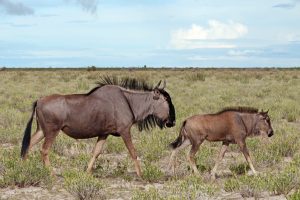Brindled Gnu
- Scientific Name : Connochaetes taurinus

- It is also called the common wild beast, white-bearded gnu or brindled gnu, is a large antelope and one of the two species of wildebeest.
- The blue wildebeest is a herbivore, feeding primarily on short grasses.
- The blue wildebeest is native to Angola, Botswana, Eswatini, Kenya, Mozambique, South Africa, Tanzania, Zambia, and Zimbabwe.
- The blue wildebeest is known to hybridise with the black wildebeest. The differences in social behaviour and habitats have historically prevented inter specific hybridisation, but it may occur when both species are confined within the same area, and the offspring are usually fertile.
- The diploid number of chromosomes in the blue wildebeest is 58.
- The blue wildebeest exhibits sexual dimorphism, with males being larger and darker than females.
- This broad-shouldered antelope has a muscular, front-heavy appearance, with a distinctive robust muzzle.
- Both sexes possess a pair of large horns, which are shaped like parentheses.
- The blue wildebeest is mostly active during the morning and the late afternoon, with the hottest hours of the day being spent in rest.
- The blue wildebeest is a herbivore, feeding primarily on the short grasses which commonly grow on light, and alkaline soils that are found in savanna grasslands and on plains.
- The blue wildebeest is native to Kenya, Tanzania, Botswana, Zambia, Zimbabwe, Mozambique, South Africa, Eswatini, and Angola. Today, it is extinct in Malawi, but has been successfully reintroduced into Namibia.
- Major human-related factors affecting populations include large-scale deforestation, the drying up of water sources, the expansion of settlements and poaching.
